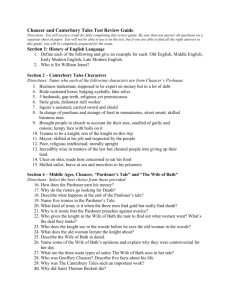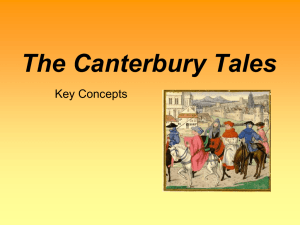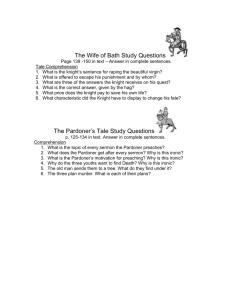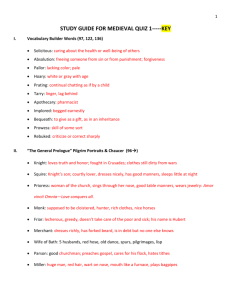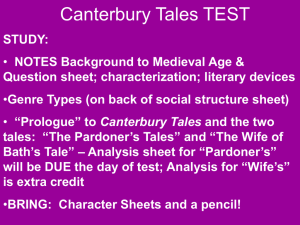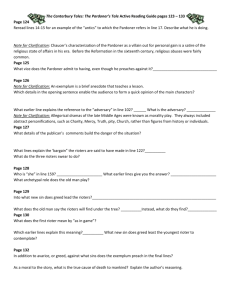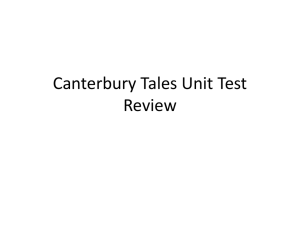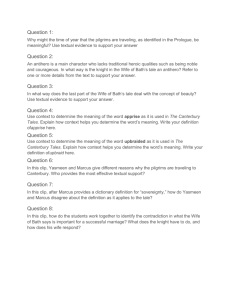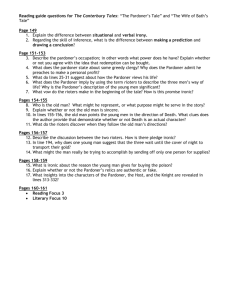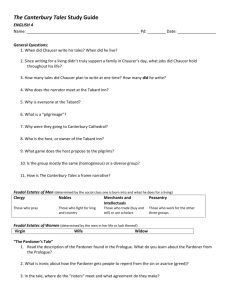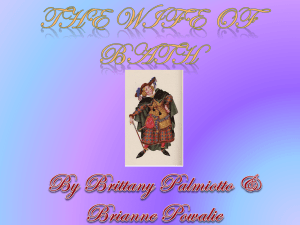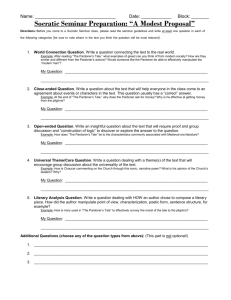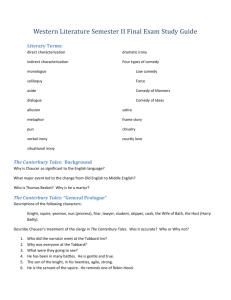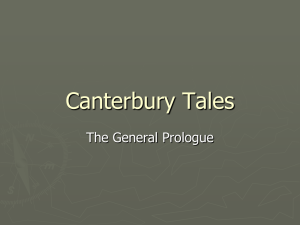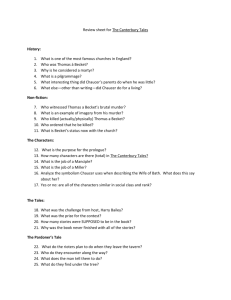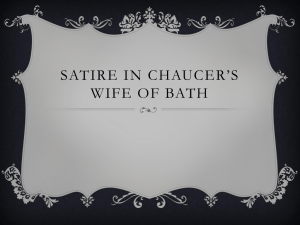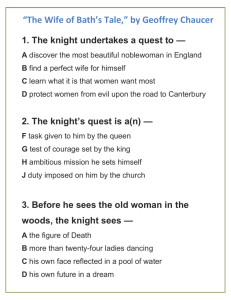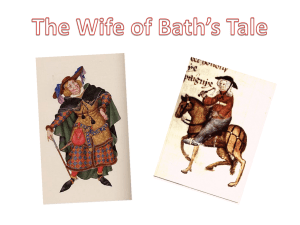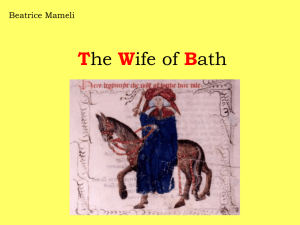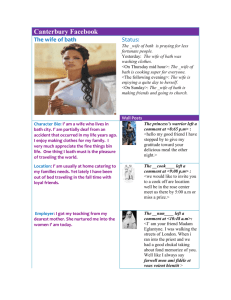canterbury tales
advertisement
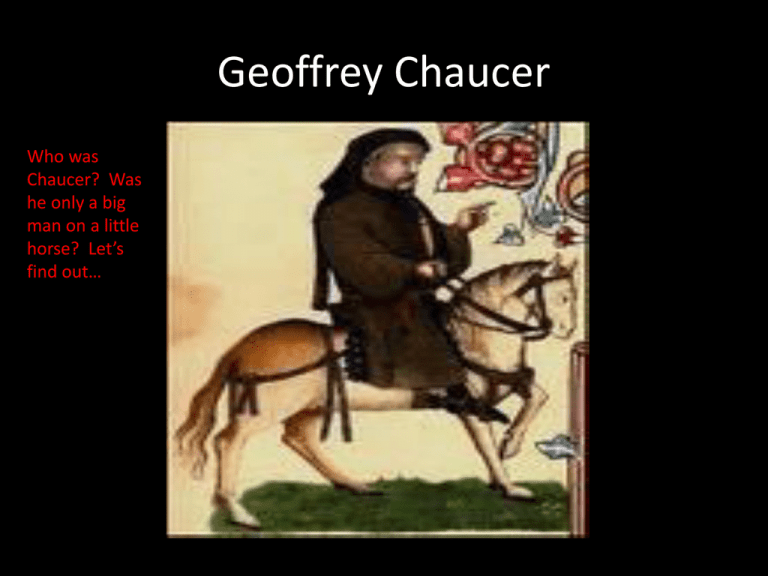
Geoffrey Chaucer Who was Chaucer? Was he only a big man on a little horse? Let’s find out… • • • • • • Quick Biographical Sketch Born 1340-1343 in London. Was not born into nobility, however was of the higher middle class and hence could read which is a good thing for us. Became an “attendant” for the King’s son and quickly was schooled in the ways of the elite. In 1377 he became a member of Parliament and became knight of the shire (no hobbits in this tale—sorry). Between 1380-1390 he wrote The Canterbury Tales which became the first English work of importance. Was captured and held for ransom while fighting in the Hundred Years’ War. First literary P.O.W. (Hemingway would be jealous) Who Murdered Chaucer? • Chaucer died on October 25, 1400 from unknown causes (grounds for a conspiracy theory). • A recent book, Who Murdered Chaucer?, suggests that Chaucer may have been killed by Richard II’s enemies (aka Henry IV) for his political affiliations. • This is pure speculation, but an interesting thought nonetheless. The Tales • Frame story—a collection of narratives woven together to produce one story. • Story is made up of 30 pilgrims traveling to the shrine of Canterbury. • They agree to have a storytelling contest as a means to pass the time. • The group consists of farmers, townsfolk, clergy, saints, and sinners. Let’s Meet Our Characters The Wife of Bath 1.Seamstress is her official title, however we can say she is a “professional wife.” 2. Married 5x 3. Claims she is educated in the art of love. 4. Deaf in one ear, a gap in her front teeth and was considered to be attractive by medieval standards. 5. Had a taste for rich attire and arguing. The Pardoner 1. Long, greasy yellow hair. 2. Beardless 3. Carries fake relics around. 4. Sells salvation from eternal damnation for a price. 5. He’s a hustler. In The Words of Diddy, “More Money, more problems…” The Pardoner’s Tale • Tale examines the question: does money corrupt or lead to problems? • Tale is an example of an exemplum—a short anecdote or story that illustrates a moral point. Historical Context • Written during the bubonic plague which wiped out about 40% of England’s population. • Death then becomes a central theme in everyday life and literary works. • Here’s an awesome explanation of what the black death was: http://www.history.com/topics/bl ack-death/videos#coronersreport-plague • One quick caveat: new research suggests that the plague was spread human to human and not by rats. Read the article at: http://www.guardian.co.uk/world /2011/aug/17/black-death-ratsoff-hook Vocabulary Words for Canterbury Tales Copy down the following words in your vocabulary section of your binder. Define the words as they appear in your reading. 1. Avarice 2. Castigate 3. Parley 4. Bequeath 5. Crone 6. Implore 7. Rebuke 8. Sovereignty 9. Temporal Review of Irony Irony—contrast between expectation and reality. Types of irony: 1. Situational irony—when a character or reader expects one thing to happen but something else occurs. 2. Verbal irony—when a character says one thing but means another. 3. Dramatic irony—when the reader is aware of something that a character is not. Guided Reading Questions The Prologue • Why would the pardoner admit his own corruption in the prologue? • In lines 39-47, why does the Pardoner tell his moral stories? How is his motive ironic? The Pardoner’s Tale • How does the Pardoner create death into a character in lines 72-89? • What does the rioters’ treatment of the old man reveal about them? • Why is the character of the old man included in the tale? • Characters in an exemplum are usually good or evil, what category would the gambler fit into and why? • In what way is the discovery of the rioters make ironic? • Who is the “Fiend” in line 243? Why does the Pardoner align the rioters with this character? • In lines 300-340 the Pardoner attempts to swindle money from the fellow pilgrims. How is this ironic? 9/14 Quickwrite: do men and women understand each other’s needs? The Wife of Bath Context • A tale about the differences between men and women. • An examination of social hierarchy based upon gender. • An account of women’s rights and subjection to male authority. • Told by a female narrator which provides a unique perspective on the issues raised. Historical Context • Knighthood began under the pretenses of chivalry, however by Chaucer’s day the only men who could afford to be knights were aristocrats. • Hence knighthood became associated with an abundance of wealth not chivalry. The Wife of Bath Prologue • After reading the Prologue what opinions do you think the Wife of Bath has on men and marriage? • What is unusual about the Wife of Bath’s character telling a tale on marriage? Would you listen and take advice from someone with her history? The Wife of Bath D2 • At the opening of the tale, the knight is convicted of what crime? What does this crime suggest about the knight’s character and views on women? • What does the queen ask the knight to find out on his quest? Why would she ask this of him? • In lines 101-110 the narrator reveals her opinion on male flattery, what are they? Do you agree? • The knight discovers many opinions on what women want. Identify several of the opinions and state your position. • The crone reveals to the knight what women want. What then is the key to understanding women? • At the end of page 191, why is the knight so distraught? Do you side with the knight, why or why not? The Wife of Bath D3 • According to the knight’s wife, what gives a man the distinction of being a great gentleman? • Who ultimately is able to give this title? How might this be seen as a commentary of knighthood during Chaucer’s time? • In lines 360-365 the knight’s wife redefines the term poor. What is her definition of poor? Do you agree with this? • Why is it important that the knight’s wife make reference to Greek and Latin classic texts? How does this illustrate her point and position? • What is the importance of allowing the wife to decide the answer to the question, “Which would you have?” • At the end of the tale we learn the Wife of Bath’s attitude toward controlling husbands. Was she ahead of her time? The Canterbury Tales Assessment Take one of the two moral lessons from the tales studied and write a modern version of the story. Requirements: 1. 1-2 pages TYPED 2. Uses a moral learned from one of the two tales. 3. Setting and characters is modern. 4. Due—9/21. Counts as a project grade.
